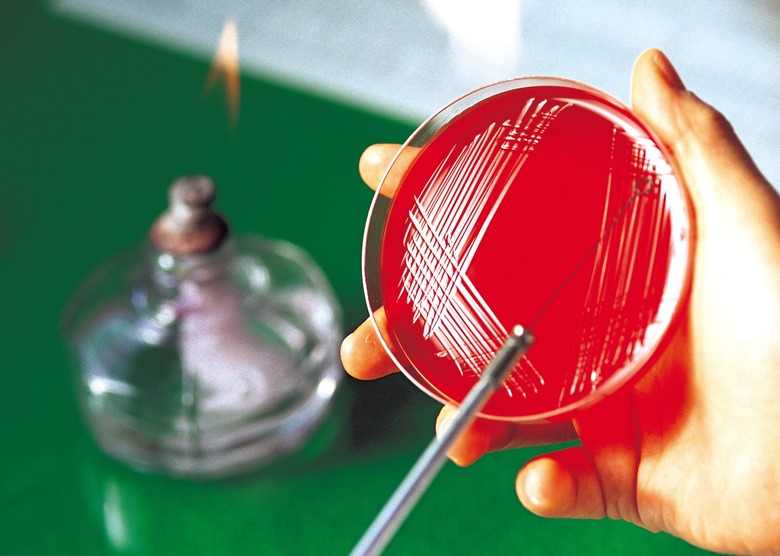What Are The Characteristics Common To All Bacteria?
Often regarded as the simplest life forms, bacteria make up a diverse group of organisms. The diversity of bacteria has led this group to be divided into two domains of life, the Eubacteria and Archaea. Despite this diversity, bacteria share a number of characteristics, most notably having prokaryotic cells. Additionally, there are a number of characteristics such as cell wall composition widely shared among the eubacteria and archaeans, though the existence of some bacteria without these nearly ubiquitous characteristics underscores their diversity.
Single-Celled
Single-Celled
Perhaps the most straightforward characteristic of bacteria is their existence as single-celled organisms. While most bacteria, archaeans and eubacteria alike, spend their entire microscopic life cycle as independent single cells, some such as the soil-dwelling myxobacteria will form multicellular fruiting bodies as part of their life cycle.
Absent Organelles
Absent Organelles
Eukaryotic cells, such as those of plants, animals and fungi, possess a membrane-bound nucleus that compartmentalizes the cell's DNA from the rest of the cell. Other functions within these cells are also sequestered into specialized membrane-bound organelles, such as mitochondria for cellular respiration and chloroplasts for photosynthesis. Bacteria lack a nucleus and complex organelles within their cells. This is not to say that bacteria do not possess internal organization, as their DNA is often sequestered into a region of the bacterial cell known as the nucleoid. However, it is important to note that the nucleoid is not physically separated from the rest of the cell by a membrane.
Plasma Membrane
Plasma Membrane
While plasma membranes are common throughout other living cells, these membranes are not a feature of bacteria. The absence of internal organelles relegates many functions that occur within eukaryotic cells to occur on the plasma membrane of bacteria. For example, special infoldings of the plasma membrane allow photosynthetic bacteria to perform the light-dependent reactions of photosynthesis that photosynthetic eukaryotes conduct on the thykaloid membranes within the chloroplast.
Cell Walls
Cell Walls
A peptidoglycan cell wall is a common feature among eubacteria. This cell wall envelops the bacteria cell, providing strength and preventing rupture in changing environments. One of the fundamental tests performed in identifying bacteria is the Gram stain, which categorizes eubacteria as Gram positive or Gram negative based on the ability of the cell wall to retain crystal violet dye. The cell wall is the target of the antibiotic penicillin and its derivatives. Penicillin inhibits cell wall formation and can destroy the walls, especially in rapidly growing and multiplying bacteria. Again underscoring the diversity within this group, not all eubacteria possess a peptidoglycan cell wall. The cell wall of chlamydia lacks peptidoglycan. Mycoplasma lack any cell wall. Archaeans also possess a cell wall but use substances other than peptidoglycan.
DNA
DNA
The multiple, linear chromosomes often represented graphically in biology textbooks are specific to eukaryotes. Conversely, both archaeans and eubacteria possess a single-circular chromosome and a DNA sequence much shorter than that found in eukaryotes. The shorter DNA sequence may partially be explained by the comparatively reduced complexity of bacterial cells but also results from the reduced presence of introns — segments of a gene that are removed during translation of the DNA into protein. The bacterial genome is augmented by smaller fragments of DNA known as plasmids, though these are not unique to bacteria and are also be found in eukaryotes. Plasmids are replicated within the bacterial cell independent of the bacterial chromosome and may be exchanged between different bacterial organisms. Plasmids may impart attributes to the host cell such as antibiotic resistance.
References
- Florida State University Molecular Expressions: Bacterial Cell Structure
- University of South Carolina School of Medicine Microbiology and Immunology Online: The Bacterial Cell
- Community College of Baltimore County: Prokaryotic Cell Structure
- Antimicrobial Agents and Chemotherapy; Lack of Cell Wall Peptidoglycan versus Penicillin Sensitivity; J. Ghuysen and C. Goffin; Oct. 1999
Cite This Article
MLA
Chandler, David. "What Are The Characteristics Common To All Bacteria?" sciencing.com, https://www.sciencing.com/characteristics-common-bacteria-11367849/. 9 March 2018.
APA
Chandler, David. (2018, March 9). What Are The Characteristics Common To All Bacteria?. sciencing.com. Retrieved from https://www.sciencing.com/characteristics-common-bacteria-11367849/
Chicago
Chandler, David. What Are The Characteristics Common To All Bacteria? last modified March 24, 2022. https://www.sciencing.com/characteristics-common-bacteria-11367849/
